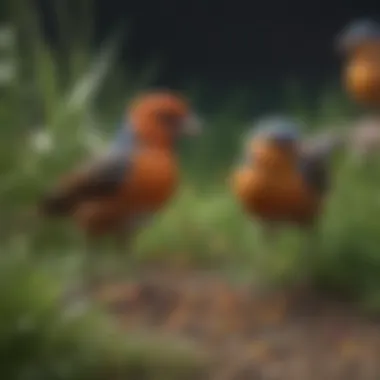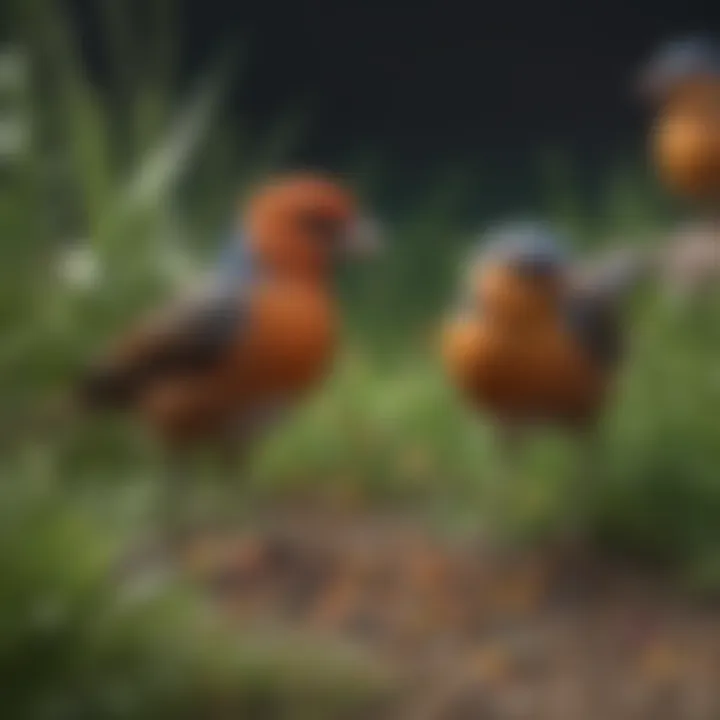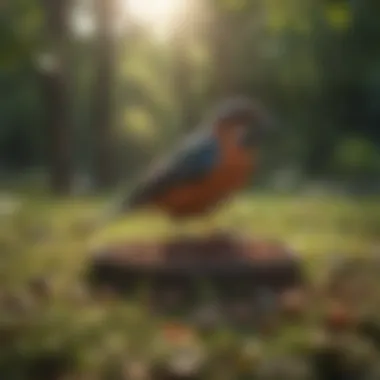Exploring Dietary Habits of Birds: Grass Seed Focus


Intro
Understanding the dietary habits of birds, especially their consumption of grass seeds, is an essential part of avian ecology. Birds play a significant role in our ecosystems, particularly within grasslands. Observing what they eat helps to recognize their impact on the environment. In this exploration, we will analyze the nutritional value of grass seeds and how these reflect on bird health and behavior.
Birds rely on grass seeds for energy and sustenance. Diet varies widely among species, influenced by availability and seasonal changes. A deeper understanding of their food choices can lead to better gardening practices and the cultivation of suitable habitats for these birds.
This article will cover several key aspects:
- Nutritional analysis of grass seeds
- How birds contribute to grassland ecosystem health
- Seasonal variations in feeding habits
- Practical implications for homeowners and gardeners
By delving into these areas, we can appreciate the interconnectedness of bird dietary habits and grassland health.
Preface to Birdseed Consumption
The examination of birdseed consumption highlights an essential component of avian dietary practices. Understanding how birds utilize different types of seeds—particularly grass seeds—sheds light on their ecological interactions and foundational dietary needs. This section lays the groundwork for discussing various feeding behaviors, nutritional values, and habitats that influence bird feeding habits.
Avian species exhibit diverse feeding strategies, with some being granivorous, meaning they primarily consume seeds. Grass seeds play a vital role in the diets of many bird species, serving as a fundamental energy source. This leads to a multitude of implications for avian health, reproductive success, and overall population dynamics.
Moreover, the focus on birdseed consumption allows an exploration of how the availability and distribution of specific seeds affect birds. These elements are crucial for creating bird-friendly environments, making this understanding particularly relevant to homeowners, gardeners, and conservation enthusiasts. By recognizing the dietary habits of birds, individuals can better cater to their needs through suitable feeding practices and habitat enhancements.
Overview of Avian Feeding Habits
Bird feeding habits encompass a range of behaviors and preferences influenced by various environmental cues. Birds are opportunistic feeders, often adjusting their diets based on availability and seasonality. Factors such as local vegetation, climatic conditions, and competition among species play significant roles in shaping these feeding habits.
In general, many birds have preferred food types. For example, some species selectively forage for seeds, while others might consume insects, fruits, or nectar. Studies indicate that the time of day also affects feeding behavior; many birds are more active during the early morning and late afternoon when foraging is most efficient. This flexibility in diet can help birds adapt to sudden changes in their environment, ensuring their survival in varying conditions.
Importance of Grass Seeds in Avian Diets
Grass seeds hold substantial importance in avian diets due to their nutritional profile. They are often rich in carbohydrates, fats, and proteins, which are essential for energy and growth. For many granivorous bird species, grass seeds are not just a food source, but a critical component for maintaining overall health and vitality.
The consumption of grass seeds helps in optimizing breeding cycles. Many species rely on the availability of seeds during nesting periods to provide adequate nutrition for their young. Furthermore, the nutrient density of grass seeds supports adult birds during migratory journeys, where energy conservation is crucial.
Types of Birds that Consume Grass Seeds
Understanding the types of birds that consume grass seeds is vital for appreciating their role in ecosystems and the nutritional dynamics of their diets. Grass seeds serve not only as a food source but also as a means of sustenance linked to broader ecological functions. Identifying these granivorous birds helps in tailoring environmental management and conservation efforts to suit their feeding patterns and habitat needs. This knowledge supports gardeners and wildlife enthusiasts in creating suitable environments that attract and nurture these species.
Granivorous Species
Granivorous birds are defined by their diet primarily consisting of seeds. Common examples include species such as the American Goldfinch, House Sparrow, and Eastern Meadowlark. These birds exhibit remarkable adaptations for seed consumption, which can be observed in their beaks that are often stout and conical. Such anatomical features enable them to efficiently crack open hard grass seeds to access their nutritious interiors.
The feeding habits of these species vary. For instance, the American Goldfinch primarily feeds on thistle and dandelion seeds, showing a preference for small grains. In contrast, the House Sparrow is often found in urban areas, consuming different types of seeds that are available from bird feeders or leftover grains from agricultural practices. Understanding these dietary preferences is important for both ecological research and practical gardening.
Seed-Eating Habitats
Birds that consume grass seeds are typically found in various habitats that provide ample food sources. Common environments include grasslands, fields, and even urban areas where gardens and parks are present. These settings offer a rich diversity of grass species, which is crucial for sustaining granivorous birds.
Grasslands are prominent habitats for seed eaters due to their extensive coverage of grass species that produce plentiful seeds. These areas not only provide food but also serve as breeding and shelter sites for many birds. Urban areas may also support granivorous bird populations by offering feeders stocked with commercially available seeds, thus creating opportunities for observers and birdwatchers to engage with these species in their environments.
Nutritional Value of Grass Seeds
Understanding the nutritional value of grass seeds is crucial for establishing their significance in the diets of various bird species. Grass seeds serve as a vital food source, providing essential nutrients necessary for avian health and well-being. The composition of these seeds affects not only the survival and growth of birds but also their reproductive success. As different species have unique dietary requirements, recognizing the nutritional aspects of grass seeds can facilitate better feeding practices in both natural settings and garden environments.
Macronutrient Composition
Grass seeds are primarily composed of three macronutrients: carbohydrates, proteins, and fats. These components play key roles in avian nutrition.
- Carbohydrates: Grass seeds typically have a high carbohydrate content, which serves as the main energy source for birds. Energy is crucial during flight, migration, and daily activities. Seeds like millet and oats are especially rich in carbohydrates, making them preferred choices for many granivorous birds.
- Proteins: Proteins are essential for growth, tissue repair, and overall bodily functions. Many grass seeds contain moderate levels of protein, which supports the development of young birds. For instance, the protein content of quinoa seeds can be beneficial for seed-eating birds by providing the essential amino acids needed for their metabolism.
- Fats: Though present in lower quantities, fats are also an important macronutrient, contributing to energy reserves. Sunflower seeds, for example, are known for their higher fat content, providing a concentrated energy source for birds, especially during colder seasons.
Vitamins and Minerals in Grass Seeds


The vitamin and mineral content of grass seeds further enhances their importance in the diet of birds. Certain vitamins and minerals are vital for maintaining health and productivity in avian populations.
- Vitamins: Grass seeds can provide essential vitamins such as vitamin E and B-complex vitamins. Vitamin E is an antioxidant that supports immune function, while B vitamins play a significant role in metabolism and energy production. The presence of these nutrients in seeds can lead to healthier birds and a lower rate of disease.
- Minerals: Important minerals such as calcium, phosphorus, and magnesium are found in various grass seeds. For birds, calcium is crucial for eggshell development, bone health, and metabolic processes. Hence, seeds that are higher in mineral content, like canary grass, can be particularly beneficial during breeding seasons.
The nutritional value of grass seeds significantly influences avian populations and their behaviors, showcasing a complex relationship between diet and ecology.
Birds' Role in Grassland Ecosystems
Birds play a crucial role in maintaining the balance of grassland ecosystems. Their interactions with flora and fauna significantly influence plant growth and species distribution. This section explores how these avian creatures contribute to ecological health through two primary mechanisms: seed dispersal and their impacts on plant communities.
Seed Dispersal Mechanisms
Birds wind up being effective seed dispersers primarily due to their feeding habits. When birds consume grass seeds, they often travel considerable distances before they excrete the seeds, allowing them to germinate in new locations. This process enriches soil diversity and encourages plant growth in areas where grassland may be sparse.
Several bird species are notable for their seed-dispersing abilities. For instance, species like the American Goldfinch and the Indigo Bunting are frequent visitors to grasslands and gardens, eating seeds and traveling away from the parent plants. As these birds move, they scatter the seeds, assisting in the creation of new growth. Their fecal matter often provides a nutrient-rich environment for the seeds, supporting successful germination.
Furthermore, some seeds require specific conditions for germination that may be naturally provided by the passing digestive system of birds.
"Birds not only consume seeds but also assist in the propagation of grassland plants, serving as natural gardeners of the ecosystems they inhabit."
Impacts on Plant Communities
The presence of birds in grassland areas can influence the composition and health of plant communities. Their foraging activities can lead to selective pressure on certain plant species. Birds tend to prefer high-energy seeds, which can favor plants that produce these seeds over time. This selective foraging may promote biological diversity by allowing less common species the opportunity to thrive when predation pressure from birds is reduced.
Additionally, the competition among various bird species for seed resources provides a natural regulatory mechanism. Different species may target different seeds or feeding areas, reducing direct competition and thus allowing a greater variety of plants to flourish. Such dynamics foster a more robust ecosystem by promoting a diverse array of plant species that provide habitat and food for numerous other organisms, creating a vibrant, interconnected biological network.
Through these mechanisms, birds undeniably facilitate ecosystem resilience, making them indispensable to the health and sustainability of grassland environments.
Seasonal Variations in Grass Seed Availability
Understanding the seasonal variations in grass seed availability is crucial for comprehending the dietary habits of birds. Availability of seeds fluctuates throughout the year, influenced by factors such as climate and ecological conditions. During spring and summer, the abundance of fresh seeds attracts various bird species to these habitats. Conversely, autumn and winter present unique challenges. Birds must adapt their feeding strategies to ensure survival during these less favorable months.
Spring and Summer Patterns
In spring, as the snow melts and the weather warms up, grass seeds begin to emerge. This seasonal rebirth creates a critical foraging period for birds. As new grass shoots sprout, seeds become plentiful and easily accessible. During this time, species like sparrows and finches actively seek out these nutrients. The growth of grasses leads to the proliferation of seeds, which many birds rely on for nourishment.
Birds have developed specific behaviors to take advantage of this season. They often gather in flocks, which helps them locate abundant food sources more efficiently. In many cases, they are also commonly observed using their keen eyesight to spot ripe seeds quickly.
Key points regarding spring and summer consumption include:
- Increased activity levels in bird populations.
- The emergence of different grass species, offering varied nutrient profiles.
- Enhanced competition among birds, leading to aggressive foraging behaviors.
Autumn and Winter Strategies
As autumn arrives, the landscape changes dramatically. The once-abundant grass seeds begin to diminish. Many birds must adjust or refine their foraging tactics to navigate the harsh winter months. During autumn, birds focus on gathering and storing seeds to prepare for the colder season. This behavior ensures they have enough food when resources become limited.
Winter presents the greatest challenge, as many seeds are buried under snow or ice. Birds have developed incredible memory and spatial skills, allowing them to find stored seeds. Some species even rely on other food sources, such as berries or insects, to supplement their diet.
Important aspects of autumn and winter adaptation include:
- The reliance on food caches to survive the winter.
- The strategic shift to different habitats with higher food availability.
- Adjustments in social behavior, such as forming smaller, more cohesive groups for better resource sharing.
"The way birds adjust their dietary habits according to seasonal changes reflects not just instinct, but remarkable intelligence and adaptability."
The dynamic landscape of seed availability throughout the seasons plays a critical role in the health of bird populations. By understanding these patterns, homeowners and gardening enthusiasts can create environments that support birds during each phase of the year, ultimately fostering more diverse avian communities.
Influence of Habitat on Feeding Behavior
The environment plays a crucial role in shaping the feeding behaviors of birds, particularly in their choices regarding grass seed consumption. Different habitats present various food sources, availability, and competition levels. Understanding these factors helps in grasping why certain birds prefer specific locations for foraging and feeding.
Urban vs. Rural Settings


In urban areas, birds adapt to fast-changing landscapes and food availability. Here, species such as house sparrows and rock pigeons find ample opportunities to thrive due to human activities and the nuances of urban infrastructure. Birdfeeders in residential areas provide a steady food supply, which can diversify their diet. However, urban settings often lack the varied ecosystem services found in rural areas. Therefore, some species may struggle to find natural food sources like grass seeds among the concrete and glass structures of cities.
Contrastingly, rural areas tend to host a richer diversity of habitats, including fields and wild grasses that are conducive for granivorous birds. Species like goldfinches and indigo buntings can forage effectively in these environments where grass seed abundance is higher. The overall availability of natural food sources encourages a more stable avian population in rural regions.
"Urban birds show remarkable adaptability, but they also face significant challenges compared to their rural counterparts."
Grassland Types and Bird Preferences
The type of grassland influences which birds are likely to be found in the area. There are several factors to consider:
- Native Grasslands: These areas typically host a variety of seed-producing plants, which can attract a large number of seed-eating birds. Species like Eastern meadowlarks benefit greatly from these ecologically intact environments.
- Introduced Grasslands: Sometimes, non-native grasses may dominate an area. While these grasses provide food, they often lack the nutritional value necessary for optimal bird health. Birds may prefer native species for their high-quality seeds.
- Disturbed Areas: Regions undergoing development or agricultural changes may provide temporary advantages in terms of seed availability. However, these disturbances can lead to long-term habitat degradation, which eventually affects bird populations.
Birds are remarkably selective. Their preferences change based on the type of grasses available and the seed production rate in different habitats. This selection is critical in sustaining the bird population in various environments.
Birdwatching and Grass Seed Feeders
Birdwatching, particularly in the context of grass seed feeders, holds substantial importance not only for avian enthusiasts but also for those interested in cultivating a harmonious environment in their gardens. Observing birds as they interact with different feeders can provide clues about their preferences and behaviors. It’s not merely about providing food; it’s about fostering a connection with nature. Grass seed feeders attract a variety of birds, bringing them into view and offering homeowners a chance to observe diverse species up close.
The benefits of implementing grass seed feeders are manifold. First, they serve as an essential source of nutrition during different seasons. Grass seeds are high in carbohydrates and are crucial for many bird species’ diets. Second, such feeders can easily draw common granivorous birds like sparrows, finches, and doves. This draw creates opportunities for birdwatching and can be a source of education for families, teaching children and adults alike about avian life cycles and behaviors.
Feeder Placement Strategies
Placing bird feeders correctly is key to attracting a variety of birds. Optimal feeder placement considers several factors. First, feeders should be located near natural shelter, such as bushes or trees, which provides birds with protection from predators. Additionally, selecting a position that offers a clear sightline allows birds to assess threats before approaching food. A distance of 10 to 15 feet from larger windows is recommended to prevent accidental collisions.
Furthermore, consider exposure to sunlight. Feeders in shaded areas may keep seeds fresh longer and also provide a comfortable environment for birds. The visibility of feeders to your home enhances the experience of birdwatching.
Grass Seed Blend Recommendations
Choosing the right type of grass seed blend for your feeder impacts the type of birds that visit. Affordable seed mixes, for instance, often contain sunflowers, millet, and cracked corn. These attract various species. However, tailored blends can heighten attractiveness.
For regions with a higher presence of specific birds, select blends with safflower seeds, which are favored by cardinals but less desired by some other animals. Black oil sunflower seeds are generally considered the most appealing choice for many birds due to their high oil content and ease of cracking.
Considerations for selecting seed blends include:
- Freshness: Always use fresh seeds to maintain high feeding rates.
- Purity: Ensure minimal filler content. A high filler ratio does not attract birds effectively.
- Seasonality: Be aware of seasonal preferences; finches may prefer thistle seeds in summer.
Choosing specific blends tailored to local birds enhances enjoyment in your backyard. As birds congregate around your feeders, not only do you promote local biodiversity, but you also create a delightful atmosphere worth observing in your own garden.
Conservation Considerations
Conservation considerations are crucial when the conversation shifts to the dietary habits of birds, particularly in relation to their consumption of grass seeds. The intricate relationship between birds and their environment plays a significant role in preserving biodiversity. Bird populations act as key indicators of ecosystem health, and understanding their needs becomes essential for effective conservation efforts. Moreover, grassland habitats support numerous species and are under threat from various human activities. By recognizing these dynamics, we can promote more sustainable practices that benefit both avian species and their habitats.
Impact of Agriculture on Grassland Birds
Agricultural practices greatly affect grassland habitats which, in turn, influences the bird populations that rely on them. Intensive farming methods often lead to habitat loss and fragmentation. For birds that primarily feed on grass seeds, like many sparrow species, the decline of these natural habitats can mean reduced food sources.
- Pesticide and Herbicide Use: These chemicals can kill both the plants that produce seeds and the insects that many birds rely on for protein. This creates a ripple effect in the food web, impacting entire bird communities.
- Monoculture Farming: Planting a single crop over large areas reduces the variety of seeds that birds can consume. Diverse grasslands provide a more nutrient-rich diet, which is crucial for supporting health and breeding.
- Land Use Changes: Urban expansion and conversion of grasslands into farmland reduce available habitats for many grass seed-eating species.
Promoting sustainable agricultural practices is vital. Techniques like crop rotation and organic farming can enhance soil health and create more bird-friendly environments. These practices can lead to an increase in grass seed availability, which would, in turn, support local bird populations.
Habitat Restoration Initiatives
Restoration of grassland habitats is a powerful conservation strategy that directly benefits birds. Various initiatives can help rebuild these vital ecosystems, making them supportive environments for grass seed-consuming birds.
- Native Grasses Planting: Introducing native grass species helps to restore the ecological balance. These grasses are well adapted to local conditions and become a more sustainable food source for birds.
- Controlled Grazing: Managed grazing by livestock can prevent the dominance of non-native plant species, allowing for a healthier grassland ecosystem. This practice can create open areas where young grasses thrive, increasing seed availability.
- Creating Conservation Reserves: Establishing protected areas where natural processes can occur without human interference ensures that these ecosystems remain intact. It allows birds access to undisturbed feeding grounds essential for their survival.
Practical Implications for Gardeners
Understanding the dietary habits of birds, specifically their reliance on grass seeds, provides valuable insight for gardeners. Proper knowledge of the types of grass and seeds that attract specific bird species can enhance both biodiversity and the aesthetic appeal of home gardens. This approach is crucial for creating an environment that supports local ecology while also enjoying the presence of birds.


Choosing the Right Grass Varieties
Selecting the appropriate grass varieties is not just about beautifying the landscape; it directly impacts the types of birds that will visit. Different birds have varied preferences for specific seeds, and these preferences can guide decisions in gardening.
- Warm-season grasses such as Bermuda grass or zoysia can offer excellent cover and seed production during hotter months.
- Cool-season grasses like fescues and bluegrasses may attract different birds during the spring and fall, as they provide seeds when other food sources are scarce.
Gardeners should consider mixing these varieties to extend the feeding options for the diverse avian species. Additionally, incorporating native grasses can enhance the habitat's ecological credibility. Native plants generally require less maintenance and attract bird species better adapted to local environments.
Creating Bird-Friendly Spaces
Designing a garden with birds in mind involves more than just providing grass seeds. A bird-friendly space encourages a range of avian species and fosters their well-being.
Here are essential elements to incorporate:
- Diverse Planting: Mix grasses with flowering plants and shrubs that produce fruit. This helps lure birds and provides shelter.
- Water Sources: A small birdbath or water feature becomes a central attraction. Ensure it's shallow and regularly filled to keep birds coming.
- Safe Spaces: Avoid using pesticides or chemicals that can harm birds. Creating a natural environment also minimizes hazards.
"Gardening with birds in mind promotes biodiversity and enhances the overall health of the ecosystem."
Implementing these strategies will not only attract birds but will enrich the gardening experience for homeowners. Engaging with nature in this way can lead to a deeper appreciation of local wildlife and a commitment to conservation practices.
Future Research Directions
The exploration of grass seed consumption in birds opens pathways for numerous future research directions. Understanding the dietary preferences of these avian species can greatly contribute to the fields of ecology and conservation. It is essential to study how changing environmental conditions affect these dietary habits. The interplay between climate change and food availability presents an urgent area of interest. This research can guide efforts to preserve bird populations and their habitats.
Studying Dietary Preferences Amid Climate Change
As climate change progresses, variations in temperature and precipitation patterns are likely to influence the availability of grass seeds. Investigating how different bird species adapt their dietary preferences in response to these changes is crucial. Researchers can examine shifts in feeding patterns, focusing on food sources that are becoming scarce or more plentiful. Additionally, a study on the nutritional adequacy of alternative seeds that birds might turn to can help evaluate the health implications for these populations.
Adapting to climate change also includes understanding geographic shifts in species. Some birds might migrate earlier or change their nesting habits due to temperature changes. Given that grass seeds provide essential energy, scrutinizing which birds thrive under these new circumstances can reveal significant insights about their role in the ecosystem. The implications may extend to understanding predator-prey dynamics and community interactions among species within grassland environments.
Longitudinal Studies on Population Dynamics
Longitudinal studies focusing on the population dynamics of granivorous birds provide vital information regarding trends over time. By tracking these populations, scientists can observe how fluctuations in grass seed availability influence metrics such as reproduction rates, survival, and migration patterns. This type of research is beneficial not only for monitoring bird populations but also for understanding the health of grassland ecosystems.
A continuous assessment allows for the detection of long-term trends, helping to predict future changes that might occur in response to ecological pressures. It can also uncover patterns of adaptation amongst bird populations as they face challenges from habitat loss and climate change. Collecting data over extended periods is critical for developing accurate models to forecast future dynamics within these communities.
In summary, a deeper investigation into the dietary habits of birds, particularly regarding grass seed consumption, will yield important information. This will not only enhance our understanding of avian ecology but also inform practical efforts in conservation and habitat restoration.
Closure: Understanding Avian Grass Seed Consumption
The exploration of birdseed consumption, particularly the focus on grass seeds, plays an essential role in comprehending the dietary habits of various avian species. As birds consume these seeds, they not only obtain vital nutrients but also participate in a larger ecological interplay. Understanding the significance of this aspect can illuminate how birds contribute to the grassland ecosystems and their overall health.
In this article, we have dissected the various components of avian feeding behaviors, focusing on granivorous species that greatly rely on grass seeds. These seeds offer important macronutrients and micronutrients, which are crucial for the survival and reproduction of these birds. Moreover, we have noted how seasonal variations in grass seed availability can affect the foraging behavior of birds, leading to adaptations in their feeding strategies.
Birds serve a pivotal role in maintaining the balance within grassland ecosystems. Their feeding habits influence seed dispersal mechanisms, which in turn affects plant communities. Consequently, their contributions can enhance local biodiversity. This understanding emphasizes the importance of conserving habitats that support these granivorous birds.
By synthesizing the importance of grass seeds in avian diets with practical applications for gardeners, we can foster environments that benefit both birds and plant life. Applying thoughtful gardening practices will not only help in attracting birds to our spaces but also assist in creating sustainable ecosystems.
"Understanding the dietary habits of birds is not merely an academic exercise; it informs conservation efforts and sustainable gardening practices that benefit our habitats."
Overall, recognizing the interdependence between birds and their food sources, particularly grass seeds, is vital. It leads to informed choices that promote biodiversity and healthy ecosystems.
Summation of Key Points
In summary, the examination of grass seed consumption highlights several key elements:
- Nutritional Value: Grass seeds provide essential nutrients for various bird species, impacting their health and reproduction.
- Ecological Role: Birds act as seed dispersers, influencing plant community structures and maintaining biodiversity.
- Seasonal Considerations: The availability of grass seeds fluctuates with the seasons, affecting bird feeding behaviors.
- Impact on Gardening: Sustainable gardening can enhance habitats for birds, thereby promoting ecological balance.
Each aspect discussed points to the profound relationship between grass seeds and bird populations, reinforcing the need for ongoing research and conservation efforts.
Encouraging Thoughtful Gardening Practices
For homeowners and gardening enthusiasts, understanding how to promote bird-friendly environments is critical. Here are some practical strategies to consider:
- Select Native Grass Varieties: Planting native grasses can provide food and shelter for local bird species. This helps in creating a more inviting environment for them.
- Adopt Seed Fillers in Feeders: When filling bird feeders, consider using blends that include a variety of grass seeds to attract specific bird species.
- Create Natural Habitats: Incorporate shrubs and wildflowers that complement grass seed offerings, thus attracting diverse bird populations.
- Observe Seasonal Cycles: Being aware of the seasonal changes in bird feeding habits can guide when and what type of food is best to provide.
Concluding, blending insights from avian dietary studies with practical gardening techniques can result in enriched ecosystems, benefiting both birds and their habitats.







